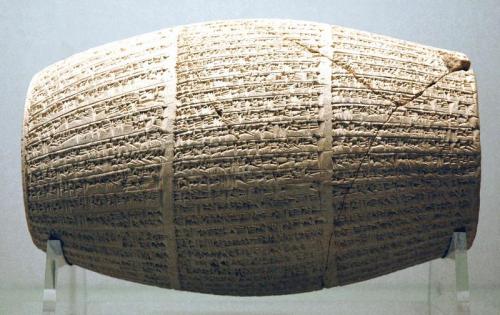Kvanvig: Surpassing the Wisdom of the Abyss–Or Not
by Estéban Trujillo de Gutiérrez
“In the Verse Account of Nabonidus the king is represented as claiming:
“He would stand in the assembly (and) exalt him[self] (as follows):
“I am wise, I am learned, I have seen what is hidden.
I do not understand the impressions made by a stylus, (but) I have seen se[cret things].
Ilteri has shown me; he has [made known to me] everything.
As for (the series) Moon Crescent of Anu (and) Enlil, which Adapa has compiled,
I surpass it in all wisdo[m].”
(Verse Account of Nabonidus v, 8′-13′, P. Machinist and H. Tadmor, eds., “Heavenly Wisdom,” in The Tablet and the Scroll. Near Eastern Studies in Honor of William W. Hallo.)
Seemingly Nabonidus is here described in the same manner as the Assyrian kings. But the scholars who wrote this in the Persian age have created a portrait with a lot of irony.

Nabonidus Cylinder, Sippar, The British Museum.
Photo by Marco Prins and Jona Lendering, Livius.org.
Currently held in the British Museum.
Released into the public domain (by the author).
https://en.wikipedia.org/wiki/Cylinders_of_Nabonidus#/media/File:Nabonidus_cylinder_sippar_bm1.jpg
First, there is an obvious irony in Nabonidus‘ boasting of being so wise when he is not able to write. The scribal art was the entrance to all kinds of wisdom for Babylonian scholars.
Second, there is an irony in relation to the god who gave Nabonidus these revelations. Ilteri is the name of the moon-god; this is no surprise since Nabonidus in the Verse Account is blamed for favoring the moon-god, Sin, instead of Marduk. Ilteri is, however, an Aramaic designation for a Syrian lunar deity.
(Cf. P.A. Beaulieu, The Reign of Nabonidus, King of Babylon 556-539 BCE. New Haven, 1989, pp. 218-9.)
Accordingly Nabonidus is not only blamed because of the neglect of Marduk, he is mocked because he thought he had received revelations from a foreign god.
At the end, there is an odd writing of the astronomical series Enuma Anu Enlil. In the name of the series, in front of Anu and Enlil, is placed a sign used to designate the moon-god.

The cuneiform on this clay cylinder mentions the renovations of the Temple of the Moon god Sin undertaken at Ur by King Nabonidus.
It includes a prayer for the king and for his son, Belshazzar.
From Ur, southern Mesopotamia, Neo-Babylonian Period, 555 BCE – 539 BCE.
Held at the British Museum, London.
Photo by Osama Shukir Muhammed Amin, released into the public domain by the author.
https://en.wikipedia.org/wiki/Cylinders_of_Nabonidus#/media/File:Cylinder_of_Nabonidus_from_the_temple_of_Shamash_at_Larsa,_Mesopotamia..JPG
This has two effects: on the one hand, it is blasphemy, since the moon-god is credited a place higher than Anu and Enlil; on the other hand it is pure nonsense–Nabonidus claims to have a wisdom surpassing a series that does not exist!

Cylinder of Nabonidus, Temple of Shamash at Larsa. This terra-cotta cylinder records the renovations by king Nabonidus of the Temple of the Sun god Shamash at Larsa.
Neo-Babylonian Period, 555 BCE – 539 BCE.
Held at the British Museum, London.
https://commons.wikimedia.org/wiki/File:Cylinder_of_Nabonidus_from_the_temple_of_Shamash_at_Larsa,_Mesopotamia..JPG
In several letters, sent from scholars to the Assyrian kings Esarhaddon and Ashurbanipal, the kings are compared with an apkallu or Adapa:
“[The king, my lord], is made [li]ke an apkallu …
… on account of that you will speak [a w]ord [that] is as perfect as that of an apkallu; a word that has been spoken just as it is meant by its nature …
Aššur, in a dream, called the grandfather of the king, my lord, an apkallu; the king, lord of kings, is an offspring of an apkallu and Adapa: you have surpassed the wisdom of the Abyss and all scholarship.
Now th[en], the deeds of the king, [my lord], are like those of Adapa.”
(S. Parpola, Letters from Assyrian and Babylonian Scholars, vol. 10, SAA, Helsinki, 1993, letter 29, rev. 2, p. 22.)
We have selected these references because they not only show that the kings are depicted as wise, but also that this wisdom has a special relationship to the wisdom of Adapa or the apkallus in general. There are numerous other testimonies where kings boast of their supreme wisdom, seeing a relationship between their wisdom and the wisdom of various gods, especially Ea.
But the apkallus are the only figures, except the gods, who have this dominant place in the royal ideology. This is not the case in early statements; it comes in the first millennium.”
Helge Kvanvig, Primeval History: Babylonian, Biblical, and Enochic: An Intertextual Reading, Brill, 2011, pp. 139-41.
